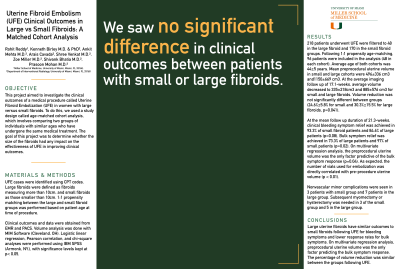Back

Women’s Health
111 - Uterine Fibroid Embolism (UFE) Clinical Outcomes in Large vs Small Fibroids: A Matched Cohort Analysis

Kenneth Briley, MD, PhD – Fellow, Interventional Radiology, University of Miami; Ankit Mehta, MD – Fellow, Interventional Radiology, University of Miami; Arais Cavada, MSN – Nurse Practitioner, Interventional Radiology, University of Miami; Shree Venkat, MD – Associate Professor, Interventional Radiology, University of Miami; Zoe Miller, MD – Associate Professor, Interventional Radiology, University of Miami; Shivank Bhatia, MD – Professor and Chair, Interventional Radiology, University of Miami; Prasoon Mohan, MD – Associate Professor, Interventional Radiology, University of Miami
Purpose: The aim of this study is to compare the clinical outcomes of UFE for large fibroids versus small fibroids using an age matched cohort analysis.
Material and Methods: UFE cases were identified using CPT codes. Large fibroids were defined as fibroids measuring more than 10cm, and small fibroids as those smaller than 10cm. 1:1 propensity matching between the large and small fibroid groups was performed based on patient age at time of procedure. Clinical outcomes and data were obtained from EMR and PACS. Volume analysis was done with MIM Software (Cleveland, OH). Logistic linear regression, Pearson correlation, and chi-square analyses were performed using IBM SPSS (Armonk, NY.), with significance levels kept at p< 0.05.
Results: 218 patients underwent UFE were filtered to 48 in the large fibroid and 170 in the small fibroid groups. Following 1:1 propensity age-matching, 96 patients were included in the analysis (48 in each cohort). Average age of both cohorts was 44±5 years. Mean preprocedural uterine volume in small and large cohorts were 496±336 cm3 and1150±669 cm3. At the average imaging follow up of 17.1-weeks, average volume decreased to 335±218cm3 and 885±576 cm3 for small and large fibroids. Volume reduction was not significantly different between groups (24.6%±5.8% for small and 30.3%±15.5% for large fibroids, p=0.041).
At the mean follow up duration of 21.3-weeks, clinical bleeding symptom relief was achieved in 93.3% of small fibroid patients and 84.6% of large patients (p=0.08). Bulk symptom relief was achieved in 73.3% of large patients and 97% of small patients (p=0.02). On multivariate regression analysis, the preprocedural uterine volume was the only factor predictive of the bulk symptom response (p=0.04). As expected, the number of vials used for embolization was directly correlated with pre-procedure uterine volume (p < 0.01).
Nonvascular minor complications were seen in 3 patients with small group and 7 patients in the large group. Subsequent myomectomy or hysterectomy was needed in 3 of the small group and 5 in the large group.
Conclusions: Large uterine fibroids have similar outcomes to small fibroids following UFE for bleeding symptoms and lower response rates for bulk symptoms. On multivariate regression analysis, preprocedural uterine volume was the only factor predicting the bulk symptom response. The percentage of volume reduction was similar between the groups following UFE.
Material and Methods: UFE cases were identified using CPT codes. Large fibroids were defined as fibroids measuring more than 10cm, and small fibroids as those smaller than 10cm. 1:1 propensity matching between the large and small fibroid groups was performed based on patient age at time of procedure. Clinical outcomes and data were obtained from EMR and PACS. Volume analysis was done with MIM Software (Cleveland, OH). Logistic linear regression, Pearson correlation, and chi-square analyses were performed using IBM SPSS (Armonk, NY.), with significance levels kept at p< 0.05.
Results: 218 patients underwent UFE were filtered to 48 in the large fibroid and 170 in the small fibroid groups. Following 1:1 propensity age-matching, 96 patients were included in the analysis (48 in each cohort). Average age of both cohorts was 44±5 years. Mean preprocedural uterine volume in small and large cohorts were 496±336 cm3 and1150±669 cm3. At the average imaging follow up of 17.1-weeks, average volume decreased to 335±218cm3 and 885±576 cm3 for small and large fibroids. Volume reduction was not significantly different between groups (24.6%±5.8% for small and 30.3%±15.5% for large fibroids, p=0.041).
At the mean follow up duration of 21.3-weeks, clinical bleeding symptom relief was achieved in 93.3% of small fibroid patients and 84.6% of large patients (p=0.08). Bulk symptom relief was achieved in 73.3% of large patients and 97% of small patients (p=0.02). On multivariate regression analysis, the preprocedural uterine volume was the only factor predictive of the bulk symptom response (p=0.04). As expected, the number of vials used for embolization was directly correlated with pre-procedure uterine volume (p < 0.01).
Nonvascular minor complications were seen in 3 patients with small group and 7 patients in the large group. Subsequent myomectomy or hysterectomy was needed in 3 of the small group and 5 in the large group.
Conclusions: Large uterine fibroids have similar outcomes to small fibroids following UFE for bleeding symptoms and lower response rates for bulk symptoms. On multivariate regression analysis, preprocedural uterine volume was the only factor predicting the bulk symptom response. The percentage of volume reduction was similar between the groups following UFE.
